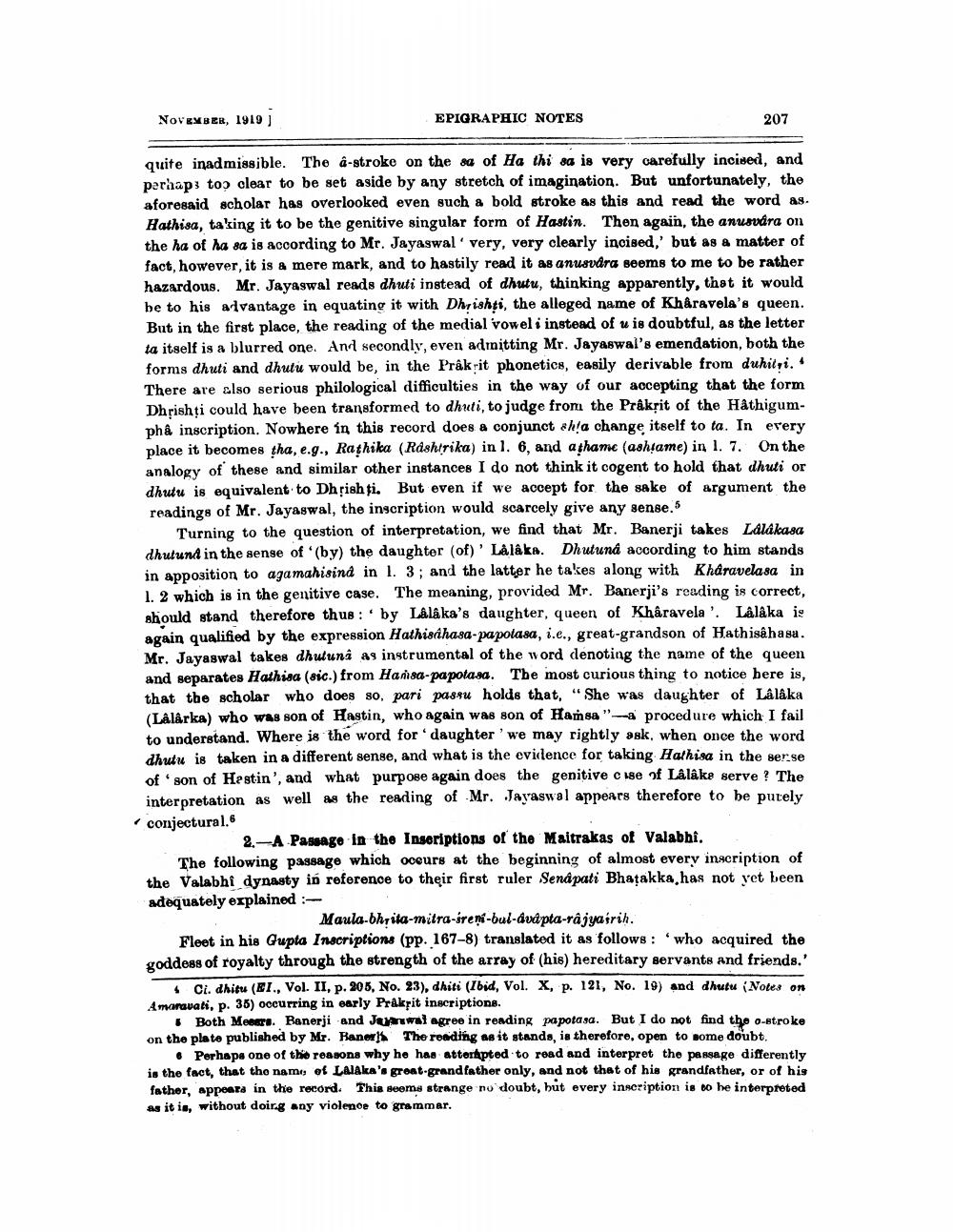________________
NOVEMBER, 1919]
quite inadmissible. The 4-stroke on the sa of Ha thi sa is very carefully incised, and perhaps too clear to be set aside by any stretch of imagination. But unfortunately, the aforesaid scholar has overlooked even such a bold stroke as this and read the word as. Hathisa, taking it to be the genitive singular form of Hastin. Then again, the anusvára on the ha of ha sa is according to Mr. Jayaswal very, very clearly incised,' but as a matter of fact, however, it is a mere mark, and to hastily read it as anusvåra seems to me to be rather hazardous. Mr. Jayaswal reads dhuti instead of dhutu, thinking apparently, that it would be to his advantage in equating it with Dhṛishti, the alleged name of Khåravela's queen. But in the first place, the reading of the medial vowel i instead of u is doubtful, as the letter ta itself is a blurred one. And secondly, even admitting Mr. Jayaswal's emendation, both the forms dhuti and dhutu would be, in the Prâkrit phonetics, easily derivable from duhitri. There are also serious philological difficulties in the way of our accepting that the form Dhrishti could have been transformed to dhuti, to judge from the Prâkrit of the Hâthigumphâ inscription. Nowhere in this record does a conjunct sha change itself to ta. In every place it becomes tha, e.g., Rathika (Rdshirika) in 1. 6, and athame (ashtame) in 1. 7. On the analogy of these and similar other instances I do not think it cogent to hold that dhuti or dhutu is equivalent to Dhrishți. But even if we accept for the sake of argument the readings of Mr. Jayaswal, the inscription would scarcely give any sense."
EPIGRAPHIC NOTES
207
"
Turning to the question of interpretation, we find that Mr. Banerji takes Lalakasa dhutund in the sense of '(by) the daughter (of) Lâlâka. Dhutund according to him stands in apposition to agamahisind in 1. 3; and the latter he takes along with Kharavelasa in 1. 2 which is in the genitive case. The meaning, provided Mr. Banerji's reading is correct, should stand therefore thus: by Lâlâka's daughter, queen of Khâravela. Lâlâka is again qualified by the expression Hathisáhasa-papotasa, i.e., great-grandson of Hathisâhasa. Mr. Jayaswal takes dhutunâ as instrumental of the word denoting the name of the queen and separates Hathisa (sic.) from Hansa-papotasa. The most curious thing to notice here is, that the scholar who does so, pari passu holds that, "She was daughter of Lâlâka (Lâlârka) who was son of Hastin, who again was son of Hamsa "a procedure which I fail to understand. Where is the word for 'daughter' we may rightly ask, when once the word dhutu is taken in a different sense, and what is the evidence for taking Hathisa in the serse of son of Hestin', and what purpose again does the genitive case of Lâlâke serve? The interpretation as well as the reading of Mr. Jayaswal appears therefore to be purely conjectural."
2. A Passage in the Inscriptions of the Maitrakas of Valabhi.
The following passage which occurs at the beginning of almost every inscription of the Valabhi dynasty in reference to their first ruler Senapati Bhatakka,has not yet been adequately explained
Maula-bhrita-mitra-ireni-bul-dvapta-rajyairih.
Fleet in his Gupta Inscriptions (pp. 167-8) translated it as follows: who acquired the goddess of royalty through the strength of the array of (his) hereditary servants and friends.'
4 Ci. dhitu (EI., Vol. II, p. 205, No. 23), dhiti (Ibid, Vol. X, p. 121, No. 19) and dhutu (Notes on Amaravati, p. 35) occurring in early Prakrit inscriptions.
Both Messrs. Banerji and Jawal agree in reading papotasa. But I do not find the o-stroke on the plate published by Mr. Baner The reading as it stands, is therefore, open to some doubt.
• Perhaps one of the reasons why he has attempted to read and interpret the passage differently is the fact, that the name of Lalaka's great-grandfather only, and not that of his grandfather, or of his father, appears in the record. This seems strange no doubt, but every inscription is so he interpreted as it is, without doing any violence to grammar.




